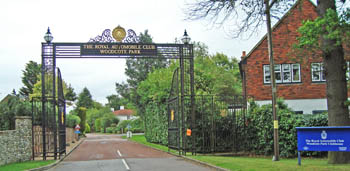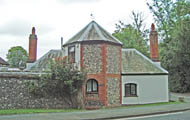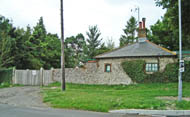Canadian Convalescent Hospital
Woodcote Park, Wilmerhatch Lane, Epsom, Surrey KT18 7EW
Medical dates:
Medical character:
Military
The Royal Automobile Club
(RAC) had purchased the 338-acre Woodcote Park estate in 1913 but, at
the outbreak of WW1 in 1914, the War Office requisitioned the property
as a training place for new recruits. The Chairman of the RAC, Arthur Stanley (1869-1947), was asked to form a 'brigade of infantry'.
Despite atrocious weather, work began in November 1914 on the building of a camp to accommodate 5,400 men and almost 200 officers. Water and drainage systems were laid and roads were built. Electric lighting and a telephone system were installed.
The camp was built in two sections - the Farm Camp and the Woodcote Park Camp - and consisted of over 100 huts for accommodation (each to house 50 men) and sanitation, a cookhouse, storerooms, mess halls, a large Recreation Hall, a barbershop, a chapel, a Post Office and a general store.
In 1915 it was decided that the camp should become a convalescent hospital for Imperial troops, mainly from Canada. In June 1915 orderlies were sent to prepare Farm Camp for the first patients.
The Canadian Convalescent Hospital opened on 5th September 1915, staffed by the Canadian Army Medical Corps. Initially the Hospital had 500 beds, but these were soon increased to 1000. The first patients to arrive, however, were ANZAC troops who had been wounded in Gallipoli. They were later joined by British servicemen.
Not all had received gun or shrapnel wounds; many were sick as disease was rife in the Army. The patients, who wore the saxe blue uniform of the convalescent soldier, had been discharged from acute hospitals and stayed for a period of six weeks until they were well enough to return to their fighting units. During their time in convalescence, they received physiotherapy from masseuses, while a staff of trained Sergeant-Instructors provided physical training and the discipline of graduated route marches. All sports were encouraged to get them back into fit condition, and the patients regularly played baseball (previously unknown in England), as well as cricket and football against the local teams. Every evening entertainments, whether home-made or from London, were provided in the Recreation Hall (which could hold an audience of 1,500) - a theatrical performance, a film show, a concert or a lecture. If fit enough, many patients were allowed to visit Epsom.
By October 1915 some 600 Canadians were also convalescing at the Hospital, which had been nicknamed 'Tin City' because of its wooden huts lined with corrugated galvanised iron. The Farm Camp section had 1,000 beds and the Woodcote Park Camp section some 500. To feed this number of patients, women were employed in the kitchens, where they did all the cooking in a specially built line of huts.
In July 1916 King George, accompanied by Queen Mary, visited the Hospital. They talked with the patients and then Queen Mary opened the 'Queen Mary's Tea Rooms'. The Hospital had over 3,000 patients, with 2,500 in the Canadian section. Only a few ANZACs were left, the New Zealanders having been transferred to the newly opened New Zealand Convalescent Hospital in Hornchurch, Essex.
Following the Somme offensive in August 1916 and the massive casualties sustained by the Canadian forces, the entire Hospital was handed over to the Canadian Army. It became its main convalescent hospital with 3,800 beds - the largest convalescent hospital in the United Kingdom. By October 1916 the number of patients had been reduced to 2,627.
In January 1918 the Hospital had 2,655 patients and, by July, some 3,500. On 10th November there were 4,142 patients. On the following day, when the war was declared to be over, some 269 were discharged.
In May 1919, six months after the war had ended, some 2,079 patients still remained, awaiting repatriation and demobilisation. Some were under treatment for 'certain vile diseases', that is, sexually transmitted diseases.
In June 1919 a serious and fatal riot took place in Epsom. Some Canadian troops had been drinking in a local public house, and a fight broke out. The civil police arrested one of the soldiers but, on the way to the Epsom police station, another tried to intervene and was also arrested. Word soon got round to the other Canadians and a determined mob stormed the police station. The rioters freed their colleagues, destroying part of the police station in the process. After the event, the Station Sergeant was found to have died from a severe blow to his head. Although five men were sentenced to five months in prison for their part in the riot, no-one was charged with the murder.
The Hospital closed ten days later, on 30th June, 1919.
Present status (August 2009)
Despite atrocious weather, work began in November 1914 on the building of a camp to accommodate 5,400 men and almost 200 officers. Water and drainage systems were laid and roads were built. Electric lighting and a telephone system were installed.
The camp was built in two sections - the Farm Camp and the Woodcote Park Camp - and consisted of over 100 huts for accommodation (each to house 50 men) and sanitation, a cookhouse, storerooms, mess halls, a large Recreation Hall, a barbershop, a chapel, a Post Office and a general store.
In 1915 it was decided that the camp should become a convalescent hospital for Imperial troops, mainly from Canada. In June 1915 orderlies were sent to prepare Farm Camp for the first patients.
The Canadian Convalescent Hospital opened on 5th September 1915, staffed by the Canadian Army Medical Corps. Initially the Hospital had 500 beds, but these were soon increased to 1000. The first patients to arrive, however, were ANZAC troops who had been wounded in Gallipoli. They were later joined by British servicemen.
Not all had received gun or shrapnel wounds; many were sick as disease was rife in the Army. The patients, who wore the saxe blue uniform of the convalescent soldier, had been discharged from acute hospitals and stayed for a period of six weeks until they were well enough to return to their fighting units. During their time in convalescence, they received physiotherapy from masseuses, while a staff of trained Sergeant-Instructors provided physical training and the discipline of graduated route marches. All sports were encouraged to get them back into fit condition, and the patients regularly played baseball (previously unknown in England), as well as cricket and football against the local teams. Every evening entertainments, whether home-made or from London, were provided in the Recreation Hall (which could hold an audience of 1,500) - a theatrical performance, a film show, a concert or a lecture. If fit enough, many patients were allowed to visit Epsom.
By October 1915 some 600 Canadians were also convalescing at the Hospital, which had been nicknamed 'Tin City' because of its wooden huts lined with corrugated galvanised iron. The Farm Camp section had 1,000 beds and the Woodcote Park Camp section some 500. To feed this number of patients, women were employed in the kitchens, where they did all the cooking in a specially built line of huts.
In July 1916 King George, accompanied by Queen Mary, visited the Hospital. They talked with the patients and then Queen Mary opened the 'Queen Mary's Tea Rooms'. The Hospital had over 3,000 patients, with 2,500 in the Canadian section. Only a few ANZACs were left, the New Zealanders having been transferred to the newly opened New Zealand Convalescent Hospital in Hornchurch, Essex.
Following the Somme offensive in August 1916 and the massive casualties sustained by the Canadian forces, the entire Hospital was handed over to the Canadian Army. It became its main convalescent hospital with 3,800 beds - the largest convalescent hospital in the United Kingdom. By October 1916 the number of patients had been reduced to 2,627.
In January 1918 the Hospital had 2,655 patients and, by July, some 3,500. On 10th November there were 4,142 patients. On the following day, when the war was declared to be over, some 269 were discharged.
In May 1919, six months after the war had ended, some 2,079 patients still remained, awaiting repatriation and demobilisation. Some were under treatment for 'certain vile diseases', that is, sexually transmitted diseases.
In June 1919 a serious and fatal riot took place in Epsom. Some Canadian troops had been drinking in a local public house, and a fight broke out. The civil police arrested one of the soldiers but, on the way to the Epsom police station, another tried to intervene and was also arrested. Word soon got round to the other Canadians and a determined mob stormed the police station. The rioters freed their colleagues, destroying part of the police station in the process. After the event, the Station Sergeant was found to have died from a severe blow to his head. Although five men were sentenced to five months in prison for their part in the riot, no-one was charged with the murder.
The Hospital closed ten days later, on 30th June, 1919.
Present status (August 2009)
The Hospital buildings then became Queen Mary's Convalescent Centre for the continuing treatment and training of ex-servicemen. It then was briefly used as a Training Centre for the War Pensions Administration. In 1923 the estate was returned to the RAC.
During WW2 the mansion house was again used as a Training Centre, while the land was given over to agriculture.
Today the estate is once again in the possession of the RAC, and is a country club with golf course.

The current main entrance to the estate on Old Barn Road off Wilmerhatch Lane, near the site of the Farm Camp (new housing along The Ridge marks the approximate site of the Woodcote Park Camp). The Woodcote Stud is shown on the right of the image.

Looking within Woodcote Park estate from the gates.


The Lodge at the original entrance on the west along Wilmerhatch Lane (left). The Lodge on what was probably the original entance on the eastern side along Langley Vale Road (right).
(Author unstated) 1915 The medical service of the Australian Imperial Force. British Medical Journal 2 (2859), 582.
(Author unstated) 1915 The hospitalization of the Canadian Expeditionary Force. British Medical Journal 2 (2859), 582-583.
http://data4.collectionscanada.ca
www.1914-1918.net (1)
www.1914-1918.net (2)
www.archive.org (1)
www.archive.org (2)
www.awm.gov.au
www.bnatopics.org (1)
www.bnatopics.org (2)
www.cefresearch.com
www.collectionscanada.gc.ca
www.epsomandewellhistoryexplorer.org.uk (1)
www.epsomandewellhistoryexplorer.org.uk (2)
www.epsomandewellhistoryexplorer.org.uk (3)
www.exploringsurreyspast.org.uk
www.francisfrith.com
www.gilliesarchives.org.uk (1)
www.gilliesarchives.org.uk (2)
www.gilliesarchives.org.uk (3)
www.gilliesarchives.org.uk (4)
www.gilliesarchives.org.uk (5)
www.gilliesarchives.org.uk (6)
www.gilliesarchives.org.uk (7)
www.superstock.com
www.yourlocalguardian.co.uk
Return to home page